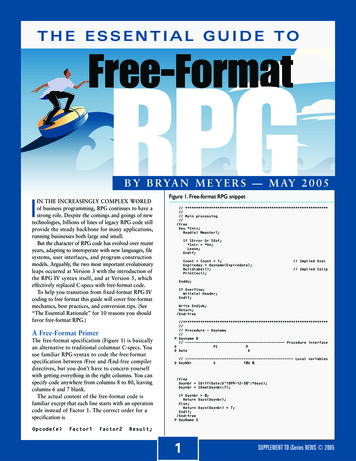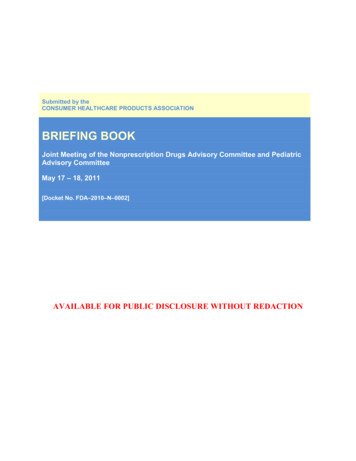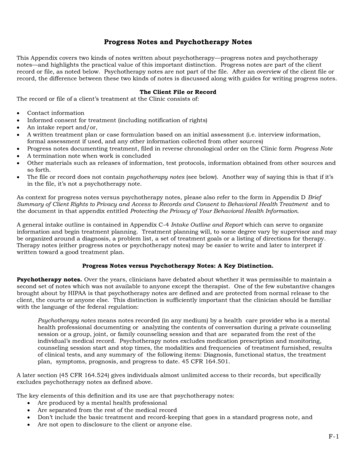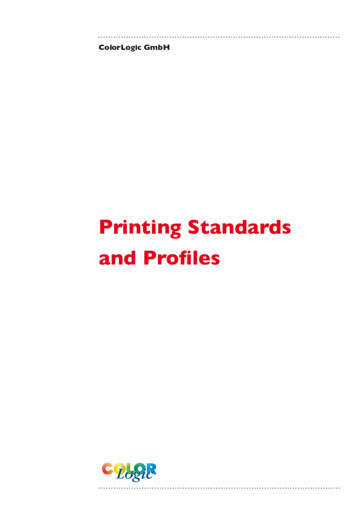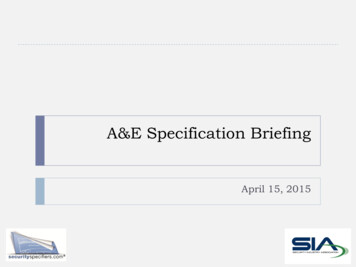
Transcription
Classic Format of aBriefing NoteRobert B. ParkinsonNothing is particularlyhard if you divide itinto small jobs.- Henry Ford
Classic Format of a Briefing NoteCopyright 2012-2017, Robert B Parkinson, OttawaThis material is available for free at WritingForResults.net.You may not sell this material. You may give it away to anyoneor quote brief passages from it, as long as you give credit tothe author, Robert B. ParkinsonPrefaceA briefing note is a powerful tool of access to leaders and colleagues — toinfluence their decisions, their actions and their understanding of issues. Inthis regard, writers (and their managers) face a challenging task. They mustdeliver expert insight and strategic acumen with brevity, clarity andprofessionalism. Beyond that, they must present it all with an optimalorganization, format and style.This guide aims to help you to excel at writing clear, crisp and compellingbriefing notes. The following pages provide: the classic format of a briefing note, along with pointers on its content; tips on how to write efficiently and effectively; advice on how to plan the foundation of a briefing note to help avoidproblems before they happen; and an outline of the strategic concepts that may be involved in writing abriefing note.You will also find a detailed discussion of the hidden costs of briefingnotes at this address.Your feedback on this material is welcomed. Please do not hesitate to sendan e-mail with any comments, suggestions or concerns that you may have.Revised: October 28, 2017
Economic AdvancementCanadaAvancement ÉconomiqueCanadaDeputy MinisterSous-ministreFOR DECISIONor PROTECTED Bor SECRETor TOP SECRET etc.Ottawa, CanadaK1A 0Z01UNCLASSIFIEDCCM #: N17-52018RDIMS #: 8340762BRIEFING NOTE FOR THE MINISTERSubject:Date:or FOR SIGNATUREor FOR INFORMATIONor FOR ACTIONThe Subject should not exceed two lines,and the bottom line should be longer than the top lineSummary 2 A well-crafted briefing note does not need a Summary. The Issue and the Conclusionor Recommendation(s) should be sufficient to summarize the briefing note.If used, the Summary should condense the key messages of the briefing note.Include a deadline for a decision, signature or action, if needed.Keep the Summary to three or four bullets.Issue3The Issue entices the Minister to read on. It states what has happened, is happening, willhappen or might happen that requires his or her attention. When appropriate, it stateswhat strengths, weaknesses, opportunities or threats exist.4Background1. Use an ArialBlack 11point font forall headings.2. Use a TimesNew Roman12-point fontfor all bodytext.3. Left-justifythe text(ragged rightmargin).4. Set the linespacing to 1.1all throughthe briefingnote.5. Note how thisparagraphsaved spaceby referringto annexes,rather thangoing intodetails here.The Background section: provides history and other information to bring the Minister up to speed on the issue; should not be controversial or subject to dispute; sets the stage for considerations; and may include current status.ConsiderationsANNEX A and ANNEX B provide guidance on writing the briefing note as a whole.ANNEX C outlines the strategic thinking that underlies a sound briefing note and thatmay form a key element of the Considerations section.Considerations provide the facts, arguments, opinions and analysis needed toshow that the Conclusion or Recommendation is a sound response to the Issue.The Considerations section may address the following as needed: current status and relevance to needs, desires and strategic priorities (e.g., SpeechFrom the Throne, the Budget, your department’s Report on Plans and Priorities); pros and cons of options, including feasibility, costs, benefits and risk;Page 1 of 25
6. Close with aConclusion ina briefingnotes that isFOR INFORMATION7. Close withRecommendation(s) in abriefing notethat is FORDECISION, FORACTION or FORSIGNATURE.8. Edit thecheck-boxlines asneeded, ordelete thisblock if it isnot required.Use the Stepby-Step Model.Ensure that thebriefing notecomplies withits Frame ofReference.Ensure relevance of thecontent to theFrame ofReference, andbe alert to theimpact of:a. substance,vs. frothb. positive vs.negativeterms;c. abstractionsvs. concretedetails; andd. facts vs.opinions vs.arguments.Use theprinciples oforganization.Use a clear andcrisp style(short words,short sentences,active verbs),with a neutraltone.UNCLASSIFIED implications for the portfolio (other agencies that report to the Minister);consultations conducted and horizontal management; andcommunications implications and plans.Considerations will deal with SWOT matters as needed, i.e.: strengths (internal capabilities);weaknesses (internal vulnerabilities);opportunities (external circumstances that can be exploited); andthreats (external circumstances that present a danger).In addressing SWOT, the Considerations section will take account of PESTLE factors asneeded, i.e.: political factors (e.g., public opinion, links to the Speech From the Throne); economic factors (e.g., budget considerations, financial impact on stakeholders); social factors (e.g., impact on education, culture, families, the elderly, employees); technological factors (e.g., technological capabilities and constraints); legal factors (e.g., requirements of law, regulations, treaties or contracts); and ecological factors (e.g., impact on wildlife, oceans, greenhouse gases).Conclusion6The Conclusion: answers the question “So what?”; and/or states the department’s position; and/or tells the Minister what happens next and when he or she will be briefed again.Recommendation(s)7The Recommendation(s) must do more than state a desired outcome. This section tells theMinister precisely what you would like him or her to do to bring about the desiredoutcome. Include a deadline, if needed (e.g., “A decision from you by March 21, 2017would enable the project to remain on schedule.”). Beyond this, do not introduce orrestate rationale in the Recommendation(s).Jean-Pierre Marchand Attachments:(3) I approve.Contacts: John Doe, 613-990-0000Technology Division, Industry Branch Jeanne Cartier, 819-991-1111Economics Division, Industry Branch I do not approve. Please discusswith my staff.Catherine R. Kathiria, P.C., M.P.Keep the noteto two pages(plus annexes).Page 2 of 28
HomeTopUNCLASSIFIEDAnnex AA STEP-BY-STEP MODEL FOR BRIEFING NOTESClick on the links in the chart for details on each element of the model.Perceivea NeedGive Yourselfa Frame iersTimelinesResponseAudienceResearch andSelect theContentSelecttheMediumDeliver tionAbstract vs.ConcreteWrittenFormatBoth Oral andWrittenStyleSubstance vs.FrothFact vs.Opinion vs.ArgumentGrammarFinal TouchesPositive vs.NegativeWho? What?When? Why?Where? How?Copyright 1978-2013, Robert B. Parkinson, Ottawa. All rights reserved.Writing a briefing note can seem like a bewildering challenge at times. But as HenryFord said, “Nothing is particularly hard if you divide it into small jobs.” The modelabove does just that for briefing notes. It sets out the tasks that we all deal with —consciously or not — in writing any briefing note. The model helps us to address thosetasks methodically and with sound reasoning.Page 1 of 2
HomeTopUNCLASSIFIEDThe step-by-step model is just a tool, however, and not a rule. No two people will use itentirely alike. In theory, you should first write a frame of reference, then develop thecontent, then select the medium, and finally prepare the briefing itself. In practice, youwill probably find yourself jumping back and forth from one stage to another. Even so,the model provides important insights into what to think about, when to think about itand how to think about it.For detailed guidance, visit How to Use the Step-by-Step Model.Page 2 of 2
TopNote the use of a table of contents.This is a lengthy annex. The tableof contents helps the reader tograsp at a glance what is in it.UNCLASSIFIEDAnnex BFrame of Reference for a Briefing NoteIntroduction . 2Strategic Perspective . 3Triggers (Drivers) . 3Strategic Goal. 3Corporate Perspective . 3Sources . 4For Further Guidance . 5Objective . 5What Do You Want to Achieve? . 5SMART Objectives . 5Being Strategic . 6Audience . 7Being Strategic . 7Intermediaries . 7The Globe and Mail Test . 7Authority . 7Being Strategic . 8Specialist Approvals . 8Barriers . 8Being Strategic . 8Timelines . 9Being Strategic . 9Cost Implications . 9Page 1 of 9
HomeTopUNCLASSIFIEDINTRODUCTIONA frame of reference is the foundation of your briefing note. It gives you sound guidanceas you do your research and writing. It will help you to keep your work focused and willhelp you avoid spending time pursuing avenues that are not relevant to the task at hand.A frame of reference has six elements: strategic perspective; objective; audience; authority; barriers; and timelines.These elements are linked to each other. Changing one can mean changing one or moreof the others as well. In light of this, a frame of reference is a valuable tool for makingsure that the foundation of your briefing is viable before you devote a lot of time toresearch and writing. You can also use it to get buy-in and guidance from yoursupervisor, partners or senior management at an early stage.Sometimes it is quick and easy to write a frame of reference. In such cases, there isnothing lost by taking the little time that is required. Other times, it will be difficult andtime-consuming to write a frame of reference. This can be an important sign that youneed to clarify what you are setting out to do before you spend a lot of time doing it.Sometimes, you will draw a complete blank when you try to write your frame ofreference. This may be one of those times when writing is a process of discovering whatyour thoughts are, rather than simply putting your thoughts on paper. In such cases, goahead and start writing. Before you finish up, however, do go back and write your frameof reference. If you still experience difficulty at this point, it is a sure sign that yourbriefing note is in trouble.The balance of this annex expands on each element of a frame of reference.Page 2 of 9
HomeTopUNCLASSIFIEDSTRATEGIC PERSPECTIVEStrategic perspective is vital to a successful briefing note. It has three components: triggers (drivers); strategic goal; and corporate perspective.Triggers (Drivers)What triggered the need for a briefing note, and what triggered the trigger? Review thetriggers closely to ensure that you clearly understand what is driving the task that you areabout to pursue. It is important to know not only what is required but also why it isrequired.Strategic GoalWhat strategic goal will the briefing note further? This is not the same as the objective ofthe briefing note. The strategic goal is a bigger purpose that validates the objective. Sucha goal might be found, for example, in (see also “Sources” below): the law; the Speech From the Throne;the Budget;the Minister’s mandate letter; oryour departmental or branch business plan.Corporate PerspectiveWhat is the corporate perspective? This is the most challenging component of strategicperspective. This is where you anticipate and think through the big picture that will be onthe minds of senior managers as they review your briefing note. Here, it is helpful to do aSWOT scan, using PESTLE as a guide.SWOT stands for: Strengths (internal capabilities); Weaknesses (internal vulnerabilities); Opportunities (external circumstances that can be exploited); and Threats (external circumstances that present a danger).Page 3 of 9
HomeTopUNCLASSIFIEDPESTLE stands for: Political factors (e.g., public opinion, relevance to the Speech From the Throne); Economic factors (e.g., budget considerations, financial impact on stakeholders); Social factors (e.g., impact on education, culture, families, the elderly, employees); Technological factors (e.g., technological capabilities and constraints); Legal factors (e.g., impact of laws, regulations, treaties or contracts); and Ecological factors (e.g., impact on wildlife habitat or greenhouse gases).SourcesHere are some internally produced documents that you might use to gain strategicperspective: mission, vision and values statements; Report on Plans and Priorities; Performance Measurement Framework; Departmental Performance Report; departmental business plan/human resource plan; program alignment architecture; internal audit and evaluation reports; departmental risk profile; and previous briefing notes.External sources that you might want to review include: laws, regulations, treaties and contracts; Speech from the Throne; Budget; Clerk of the Privy Council’s Web site; Treasury Board Secretariat Web site; Auditor General’s reports; the governing party’s election platform (but you can’t refer to this in a briefing note,even though it can provide you with vital guidance); speeches by politicians (here again, though, you cannot cite them in a briefing note inmost cases); news media reports; and public opinion surveys.You may also need to go directly to sources. You might contact any of the following(possibly requiring your manager’s permission beforehand): technical specialists (legal counsel, finance, communications, human resources, orother subject-matter experts) — both internal and external; counterparts in other departments, other governments or other organizations;Page 4 of 9
HomeTopUNCLASSIFIED your director;your director general’s staff;your assistant deputy minister’s staff;your deputy minister’s staff; andyour minister’s staff.For Further GuidanceSee Annex C – Strategy, Execution and Results Measurement for more guidance onstrategic perspective.OBJECTIVEWhat Do You Want to Achieve?In setting the objective of the briefing note, state it in terms of something you want thebriefing note to achieve, as opposed to simply going through a process. Here's anexample of a process: "To brief the Minister on our cost-sharing program." That raisesthe question: What do you want to be the outcome of that briefing? Instead, you mightsay something like this: "To ensure that the Minister is aware in advance of oppositionthat may arise to our cost-sharing program."SMART ObjectivesHere is a test of whether you have developed a sound objective. Ask yourself if it isSMART, i.e.: Specific; Measureable; Attainable; Relevant; and Time-bound.Specific What exactly do you want the Minister to do, decide, know or understand afterreading your briefing note?Page 5 of 9
HomeTopUNCLASSIFIED Does your objective embrace answers to these questions: Who? What? When?Where? Why? How? How much?Measurable How will you know whether you have achieved your objective?Can you use quantitative metrics (e.g., “How much did the Minister approve forspending on the new program?” or “How many mining communities did theMinister agree to visit in the next 12 months?”)?Can you use qualitative metrics (e.g., “Did the Minister approve the newcommunications strategy for the program?” or “Did the Minister accept the invitation tospeak at the conference?”)?Attainable What barriers stand between you and achieving your objective? Should you consider addressing each barrier in a separate initiative — say, inseparate briefing notes to the Minister, the Deputy Minister, etc.?Relevant Does your objective fall within the parameters of higher goals that have beenapproved previously (e.g., goals set out in the Budget, the Speech from theThrone, the Minister’s mandate letter, the department’s business plan)?Time Bound When must the objective be achieved in order to be useful (e.g., within sixhours, within seven days, within two months)?Being StrategicIn setting your objective, you have an opportunity to be strategic. You don't want tooverreach — but neither do you want to aim for less than what you could reasonablyexpect to achieve.Your manager can be helpful at this early stage in assessing the objective.Page 6 of 9
TopUNCLASSIFIEDAUDIENCEThe audience is the star of the show. Without an audience, you cannot achieve yourobjective.Being StrategicChoosing your audience is another opportunity to be strategic. The first audience thatcomes to mind may not be the audience that is best-suited to furthering your strategicgoal or achieving your objective.IntermediariesThe ultimate audience — say, your minister — is just one of many audiences that yourbriefing note will encounter as it makes its way up through your bureaucracy. For aministerial briefing note, the draft must be read, understood and endorsed by fivemanagers and seven or more administrative assistants, executive assistants, briefingsofficers, policy advisors and chiefs of staff. — each of whom may delay your briefingnote, edit it without consulting you, or even reject it outright if they misunderstand it.The Globe and Mail TestFinally, there is The Globe and Mail test. Briefing notes, and even drafts of briefingnotes, are subject to access to information legislation. Thus, another audience could bethe general public, and your briefing note could end up on the front page of The Globeand Mail one day. This should not deter you from offering frank advice. It should,however, be an incentive to ensure that everything in the briefing note will stand up underintense public scrutiny.AUTHORITYAuthority is the flip side of the audience. Your audience has to be matched with thesigning authority for the briefing note.Page 7 of 9
TopUNCLASSIFIEDBeing StrategicHere, you again have an opportunity to be strategic. If you or your upper managers do nothave the authority to address the audience that is needed to achieve your objective, youwill need to rethink your endeavour to identify an alternative objective and an audiencethat you do have the authority to address.Specialist ApprovalsAnother dimension of authority is approvals by specialists — such as legal counsel,communications, finance, human resources and subject-matter experts. If you need OKsfrom people such as these, it will take time, and you will need to account for this whenyou write your timelines.BARRIERSBarriers are external factors that stand between you and achieving your objective withyour chosen audience. Barriers could include: the audience's existing position on the issue (and if you don't know what it is, it isworth your while to work through back channels to find out); competing views conveyed by other stakeholders; the audience’s lack of understanding of a complex issue; time pressures that could prevent the audience from reading or even seeing yourbriefing note; and PESTLE and SWOT factors.Being StrategicYou have another opportunity to be strategic here. Do the barriers present too much of achallenge to overcome in a single briefing note? You may have to consider your optionsand develop a plan for overcoming thosbarriers — possibly: developing a series of briefing notes, each designed to overcome one or more of thebarriers; and/or seeking an opportunity to deliver an oral briefing on a complex issue.Page 8 of 9
TopUNCLASSIFIEDTIMELINESFinally, we come to timelines, which have three components: deadline — i.e., when the briefing note must be received by its ultimate audience inorder for it to achieve its objective; schedule — e.g., when your research and consultations will be done, when yourdrafting and revising will be done, when the briefing note will be translated (ifneeded), when approvals will be received from specialists and the formal line ofauthority; and personal time budget — i.e., the number of hours of your own time that the projectwill require.Being StrategicOnce again, you have an opportunity to be strategic here. Does your deadline permit youenough time to gather all the information that you want or need for thebriefing note? If not, you must make a choice: You could plow ahead and hope for the best without the missing information. You could change other elements of your frame of reference as needed to match theavailable information. You could ask for an extension on the briefing note’s deadline, if it has been requestedby others.If you need to ask for an extension, do so as soon as possible. Waiting until the lastminute makes you look incompetent and complicates life for everyone else.Cost ImplicationsAs noted above, a ministerial briefing note must be cleared by 12 or more managers,administrative assistants, executive assistants, briefings officers, policy advisors andchiefs of staff. If you are tempted to cut corners in your personal time budget for researchand writing, give some thought to what the consequences will be if any of thoseindividuals: misunderstand your briefing note; send it back to you for revision or revise it themselves without checking with you; or reject it entirely before it reaches its intended audience.You will find a detailed discussion of the hidden costs of briefing notes here. Thiscase study uses real numbers from a real department (with its name changed).Page 9 of 9
UNCLASSIFIEDAnnex CSTRATEGY, EXECUTION AND RESULTS MEASUREMENTIssue . 2Overview of Strategy . 2What is Strategy? . 2Why Do We Need a Strategy? . 3What is Strategic Planning? . 3Results Measurement . 3Logic Model . 3Degrees of Control . 5Flows of Influence . 5Environment Scans . 5External Environment . 7Internal Environment . 7Priority-Setting . 9The Need . 9The Method. 10What This Enables You to Do. 11Matters That Are Linked to Each Other . 11Risk . 12What Drives Us? . 13Anchors . 13Value Proposition, Goals and Objectives . 13Results of the SWOT Scan . 14Options . 14Objectives and Priorities . 15Execution . 16Who? What? When? Where? Why? How? . 16Communications . 16Evaluation . 16What Does Evaluation Mean? . 16Measurement Methods . 16Periodic Reality Checks . 17Fundraising . 17Subsequent Planning Cycle . 17Conclusion . 17What This Annex Has Done . 17Why It Matters for Your Briefing Note . 17Page 1 of 18
HomeUNCLASSIFIEDISSUEFor your briefing note to succeed, you will need to locate yourself and your audiencein the processes of: assessing your organization’s value proposition and goals; assessing the internal and external environments; identifying options for action, assessing risk, setting priorities and setting objectives; choosing methods to measure progress in achieving objectives; developing execution plans to achieve objectives; executing the plans; measuring progress throughout the execution cycle and assessing whether a changecourse is needed; and assessing results at the end of the execution cycle (to serve as input to the nextplanning cycle).Some of those items will not be in play in your briefing note, and you can ignore them.Others, however, will be very much at play and require close attention.OVERVIEW OF STRATEGYWhat is Strategy?A strategy is a plan to bring about desired or necessary changes in: the internal environment (e.g., a government department, say, “XL SocialServices”); and the external environment (i.e., the outside world, including the people XLSocial Services exists to serve).Different people have different ideas about what “strategy” means. What is a strategy inmy eyes might be a matter of tactics for my manager, and so on up and down the line.For purposes of a briefing note for your minister, strategy means:Decisions by the Minister on either maintaining the status quo or:o significant changes that are desired or essential within the department and inthe department’s external environment; ando how to bring those changes about.Page 2 of 18Top
HomeUNCLASSIFIEDWhy Do We Need a Strategy?A strategy is needed to take action and deliver results on: the department’s legislation, mission, mandate, vision, core values and ministerialdecisions; objectives that are approved by the Minister and influenced by input fromthe Minister, senior management, staff and stakeholders; and SWOT scans — i.e.:o a scan of the strengths and weaknesses in the internal environment; ando a scan of opportunities and threats in the external environment.What is Strategic Planning?Strategic planning means defining: where the establishment is now; where you would like it to be or where it must be; how you plan to get there; and how you will know if we got there.Results MeasurementA strategy provides the foundation for measuring the results that the departmentachieves. Those results, in turn: enable you to monitor progress and take corrective action if needed; serve as a point of reference for the next strategic planning cycle; and help you to secure funding from the government and partners.LOGIC MODELThe diagram on the next page is a logic model for the strategic management process of ourfictitious department, XL Social Services. Such a logic model can help to understand the stepsinvolved in strategic planning and to evaluate what is done at each level.Page 3 of 18Top
HomeUNCLASSIFIEDTopUltimate ts (Approvedby the Minister orCabinet)Activities of theStrategic P
Home Top UNCLASSIFIED . A frame of reference is the foundation of your briefing note. It gives you sound guidance as you do your research and writing. It will help you to keep your work focused and will help you avoid spending time pursuing avenues that are not relevant to

